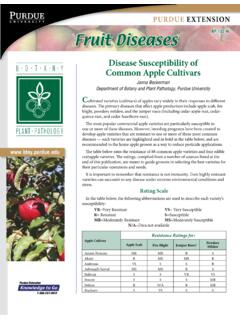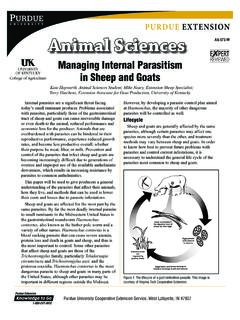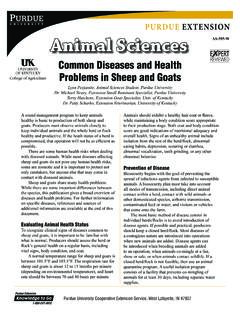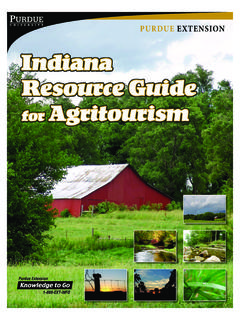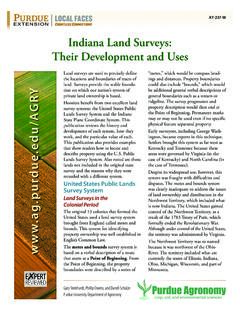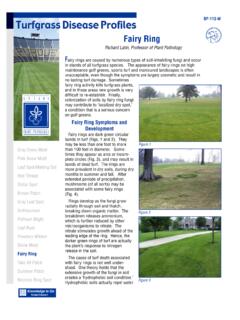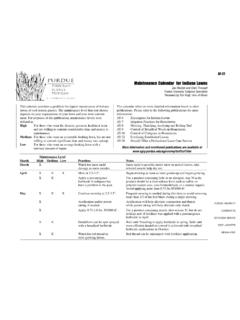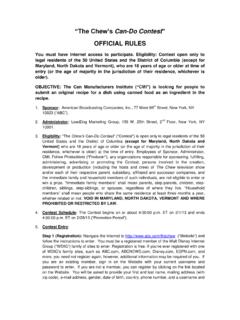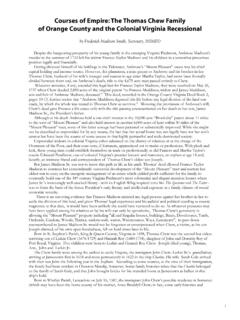Transcription of Why Do Animals Eat the Bark and Wood of Trees and Shrubs?
1 Animals gnawing the bark and wood of Trees and shrubs is not a malicious act or evidence of a neurotic condition. Instead, it is the normal means by which some Animals acquire a nutritious food source. The ability to consume this seemingly unpalatable food supply and derive nourishment from it requires specialized feeding habits and digestive systems. The most consummate wood feeders are the billions of termites throughout the world that literally devour thousands of tons of woody debris every year in forests as well as lumber in buildings. Many of our most serious and damaging insect pests are the bark beetles and wood borers that feed on the parts of Trees for which they are named.
2 Even mammals ranging in size from mice to elephants consume bark and woody branches. They all have specialized digestive systems that allow them to extract nourishment from this material, something humans cannot do. To understand how bark and wood can serve as food for these critters requires knowledge of cell wall structure, bark and wood anatomy, movement and storage of food in Trees , and the variations in digestive systems among Animals . Constituents of Plant Cell WallsUnlike Animals , plants have cells with rigid cell walls composed of cellulose, hemicellulose, and lignins.
3 Pectins help hold the individual cells together in tissues. All of these substances are potential sources of food for principal component of cell walls is cellulose, which consists of 5,000 to 10,000 glucose molecules joined by a so-called beta linkage to form straight chain polymers of pure sugar. The long chains of cellulose are combined first into microfibrils and then further into macrofibrils to create a mesh-like matrix of cell wall material, much like fibers twisted to make thread are used to weave cellulose is a pure carbohydrate, it is not a source of food for humans or most other organisms because they lack the enzymes necessary to digest it.
4 Starch, which many Animals including humans can metabolize Forestry&NaturalResourcesPURDUE UNIVERSITYFNR-203 Purdue University Cooperative Extension Service West Lafayette, IndianaPurdue UniversityForestry and Natural ResourcesWhy Do Animals Eat the bark and Wood of Trees and Shrubs? William R. Chaney, Professor of Tree PhysiologyDepartment of Forestry and Natural ResourcesPurdue University, West Lafayette, IN 47907 Cellulosebecause they produce amylase enzymes, is similar to cellulose except the long chains of glucose are linked in an alpha configuration.
5 Cellulose has as much food value as starch, but only Animals that maintain colonies of microorganisms in their gut that produce the enzyme cellulase are capable of digesting second important constituent of plant cell walls is hemicellulose, which bonds cellulose fibrils together. Hemicellulose also is a polymer, but it s more complex than cellulose because the molecule is highly branched instead of straight-chained and consists of a mixture of several kinds of sugars. Only Animals with microorganisms in their gut that produce hemicellulase enzyme can use this substance as , occurring within the cell wall matrix formed by cellulose and hemicellulose, serves as a binding agent to hold the cells together and imparts rigidity to tissues.
6 The soft nature of cotton, practically pure cellulose, is an indication of how flexible wood would be without a stiffening ingredient like lignin. Lignin is a complex polymer built of phenylpropane units. Due to its phenolic nature (phenols are often used as disinfectants), lignin tends to make wood less digestible even for Animals adapted to feeding on woody middle lamella located between cells functions somewhat as a cementing material to hold adjacent cells together. It consists of pectins and pectic acids that upon breakdown yield galacturonic acid and the sugars arabinose and of these cell wall materials are potential sources of food if the proper enzymes are available to digest them into their basic sugar and organic acid AnatomyBark consists of accumulations of crushed, dead cells of the outer bark and the inner bark of living cork cambium and functional phloem tissues that transport sugars throughout Trees .
7 The thickness and appearance of bark varies widely among different kinds of Trees and depends on the relative activity of cork cambium and the amount of fibers produced in the phloem. The dead outer bark , regardless of its thickness, is the least palatable because the cell walls are high in lignin, phenols, and the waxy substance inner bark , in contrast, has living cells with nutrient laden cell sap, organelles, and stored starch. Most importantly, the phloem cells with their sugary contents are located here. The inner bark is the chief target for Animals that feed on bark .
8 Young twigs and branches are preferred because they have a higher proportion of inner to outer bark and lower concentrations of anti-digestion compounds such as lignin and phenols. There are considerable differences among species of Trees , but all barks contain sugars, starch, cellulose, hemicellulose, and mineral elements. Wood StructureThe functional xylem or wood of Trees extends from near the tips of twigs to near the tips of roots. When mature, the water conducting xylem vessels and tracheids are dead and hollow. The only nutritional value of these cells is in the lignified cell walls.
9 The xylem also contains parenchyma cells that constitute the vascular rays as well as being located around vessels, at the boundaries between annual rings, or just scattered among the vessels and tracheids. In the functional Lignin2 Relative position of bark and xylem tissues in a tree trunkpart of the xylem, the sapwood, parenchyma cells are alive and used for storage of starch. The heartwood, in contrast, has no living cells and the starch is replaced with resins and phenols that deter fungal decay and insect feeding. Hence, the sapwood is the most appealing and digestible part of the xylem for wood feeders with its stored starch and water conducting cells containing only small amounts of anti-digestion vascular cambium is the lateral meristem from which both new xylem and phloem cells arise.
10 The succulent, expanding new xylem and phloem cells produced by the vascular cambium become a sink for sugars and amino acids, making them particularly attractive as a food and Storage of Food in TreesSome of the sugar produced by photosynthesis is used for growth at its site of synthesis, but most is transported via the phloem to other sites to sustain growth or for storage in the branches, trunk, fruits, and roots. The phloem, located in the inner bark , extends throughout Trees from the small twigs in the crown to the fine roots. Analysis of the watery sap coursing through the cells of the phloem reveals that sucrose is the principal form in which photosynthate is translocated, but sorbitol, mannitol, raffinose, stachyose, verbascose, and even amino acids also occur.
